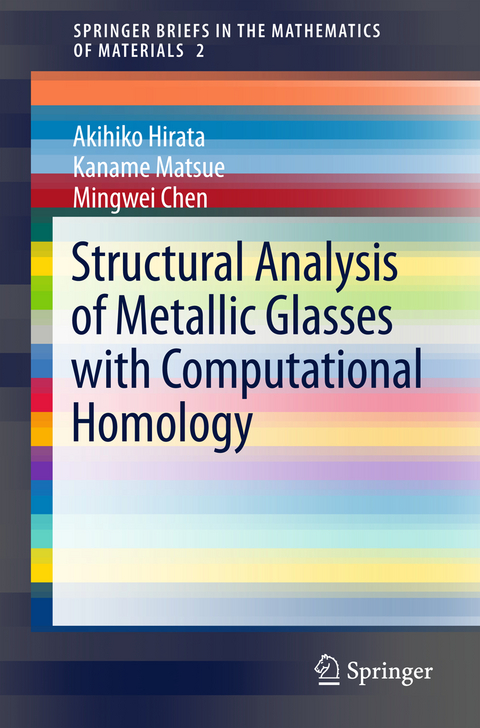
Structural Analysis of Metallic Glasses with Computational Homology
Seiten
2016
|
1st ed. 2016
Springer Verlag, Japan
978-4-431-56054-8 (ISBN)
Springer Verlag, Japan
978-4-431-56054-8 (ISBN)
This book introduces the application of computational homology for structural analysis of metallic glasses. The book begins with a brief basic survey of metallic glassesand computational homology, then goes on to the detailed procedures and interpretation of computational homology analysis for metallic glasses.
This book introduces the application of computational homology for structural analysis of metallic glasses. Metallic glasses, relatively new materials in the field of metals, are the next-generation structural and functional materials owing to their excellent properties. To understand their properties and to develop novel metallic glass materials, it is necessary to uncover their atomic structures which have no periodicity, unlike crystals. Although many experimental and simulation studies have been performed to reveal the structures, it is extremely difficult to perceive a relationship between structures and properties without an appropriate point of view, or language. The purpose here is to show how a new approach using computational homology gives a useful insight into the interpretation of atomic structures. It is noted that computational homology has rapidly developed and is now widely applied for various data analyses. The book begins with a brief basic survey of metallic glassesand computational homology, then goes on to the detailed procedures and interpretation of computational homology analysis for metallic glasses. Understandable and readable information for both materials scientists and mathematicians is also provided.
This book introduces the application of computational homology for structural analysis of metallic glasses. Metallic glasses, relatively new materials in the field of metals, are the next-generation structural and functional materials owing to their excellent properties. To understand their properties and to develop novel metallic glass materials, it is necessary to uncover their atomic structures which have no periodicity, unlike crystals. Although many experimental and simulation studies have been performed to reveal the structures, it is extremely difficult to perceive a relationship between structures and properties without an appropriate point of view, or language. The purpose here is to show how a new approach using computational homology gives a useful insight into the interpretation of atomic structures. It is noted that computational homology has rapidly developed and is now widely applied for various data analyses. The book begins with a brief basic survey of metallic glassesand computational homology, then goes on to the detailed procedures and interpretation of computational homology analysis for metallic glasses. Understandable and readable information for both materials scientists and mathematicians is also provided.
1. Introduction.- 2. Metallic glasses.- 2.1. What is glass?.- 2-2. Structure and properties of metallic glasses.- 2-3. Structure determination and its difficulty.- 3. Homology and computational homology.- 3.1. Cubical complex.- 3.2. Cubical homology.- 3.3. Computing homology groups.- 4. Structure analysis of metallic glasses.- 4.1. Advantage of computational homology.- 4.2. Preparation of input data for metallic glasses.- 4.3. Computing procedure for metallic glasses.- 4.4. Interpretation of results obtained by computational homology.- 5. Appendix.
| Erscheinungsdatum | 08.10.2016 |
|---|---|
| Reihe/Serie | SpringerBriefs in the Mathematics of Materials ; 2 | SpringerBriefs in the Mathematics of Materials ; 2 |
| Zusatzinfo | 7 Illustrations, color; 26 Illustrations, black and white; XIV, 66 p. 33 illus., 7 illus. in color. |
| Verlagsort | Tokyo |
| Sprache | englisch |
| Maße | 155 x 235 mm |
| Themenwelt | Mathematik / Informatik ► Mathematik ► Allgemeines / Lexika |
| Mathematik / Informatik ► Mathematik ► Algebra | |
| Mathematik / Informatik ► Mathematik ► Angewandte Mathematik | |
| Naturwissenschaften ► Chemie ► Physikalische Chemie | |
| Naturwissenschaften ► Physik / Astronomie ► Theoretische Physik | |
| Technik ► Maschinenbau | |
| Schlagworte | Computational homology • Cubical sets • Local atomic order • Metallic glass • structure analysis |
| ISBN-10 | 4-431-56054-8 / 4431560548 |
| ISBN-13 | 978-4-431-56054-8 / 9784431560548 |
| Zustand | Neuware |
| Informationen gemäß Produktsicherheitsverordnung (GPSR) | |
| Haben Sie eine Frage zum Produkt? |
Mehr entdecken
aus dem Bereich
aus dem Bereich
Buch | Hardcover (2023)
Hanser, Carl (Verlag)
29,99 €
Geschichten aus der europäischen Mathematik der Neuzeit
Buch | Softcover (2024)
Springer (Verlag)
29,99 €


